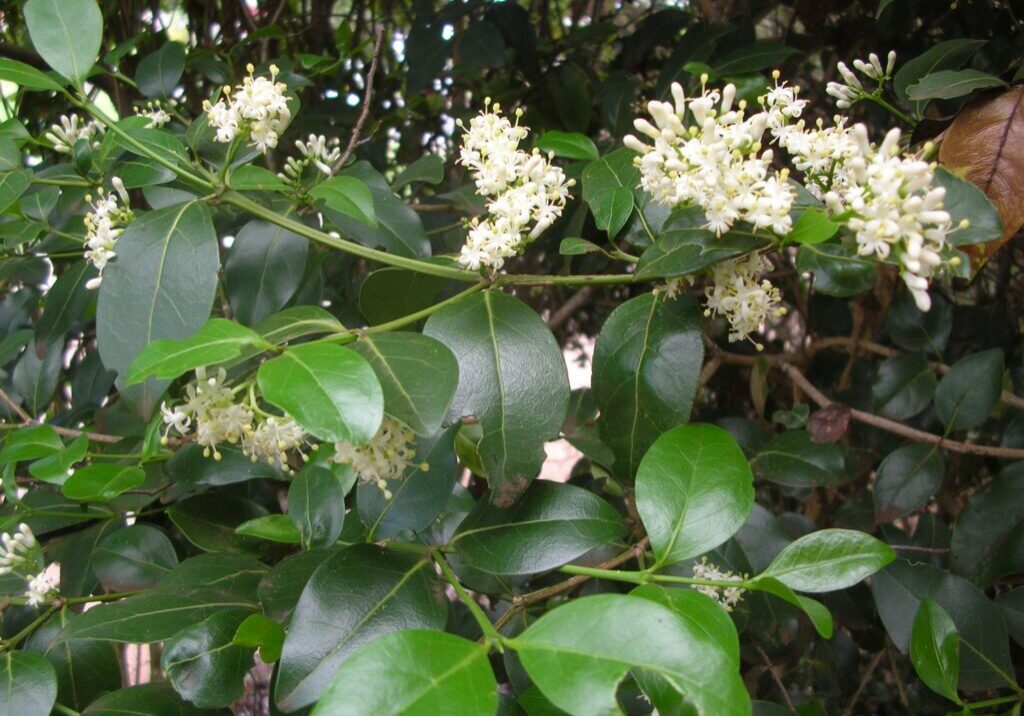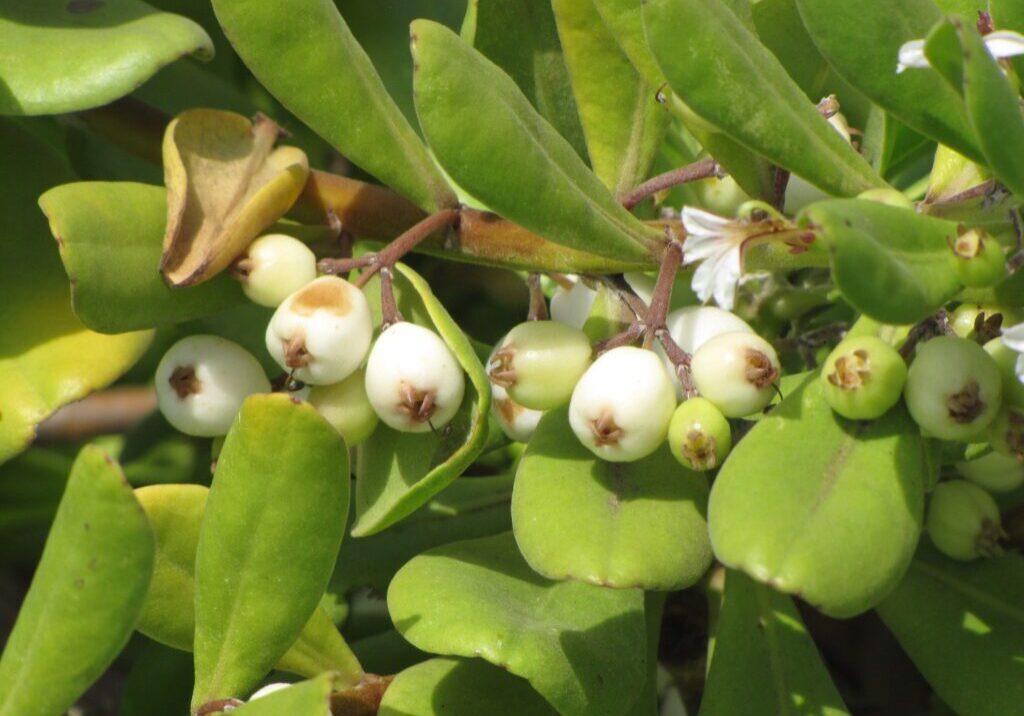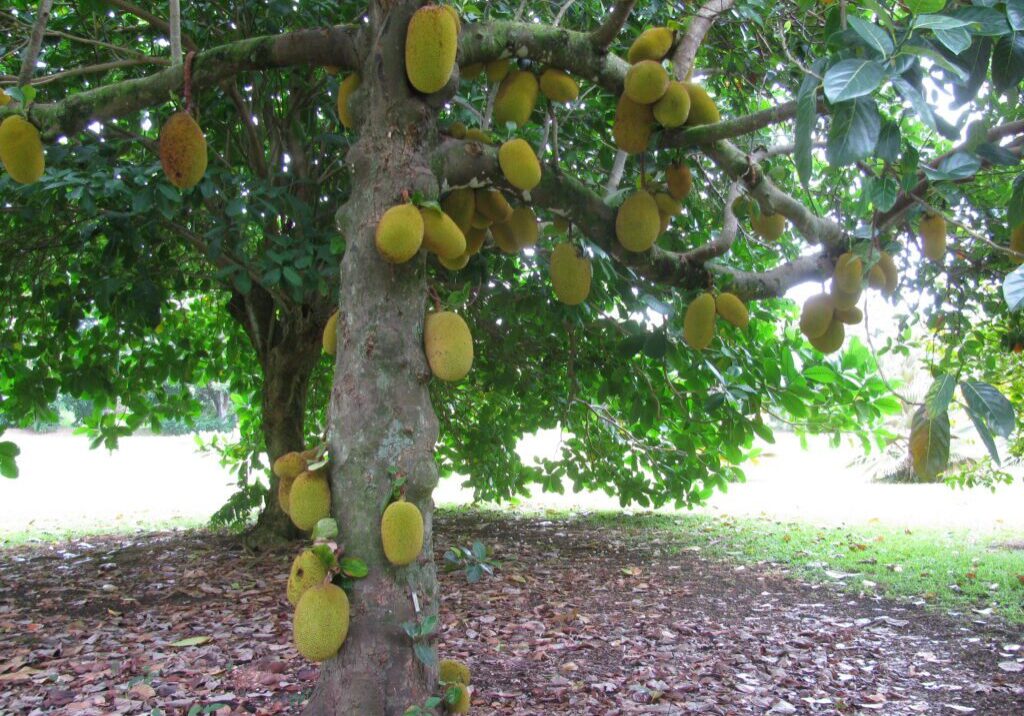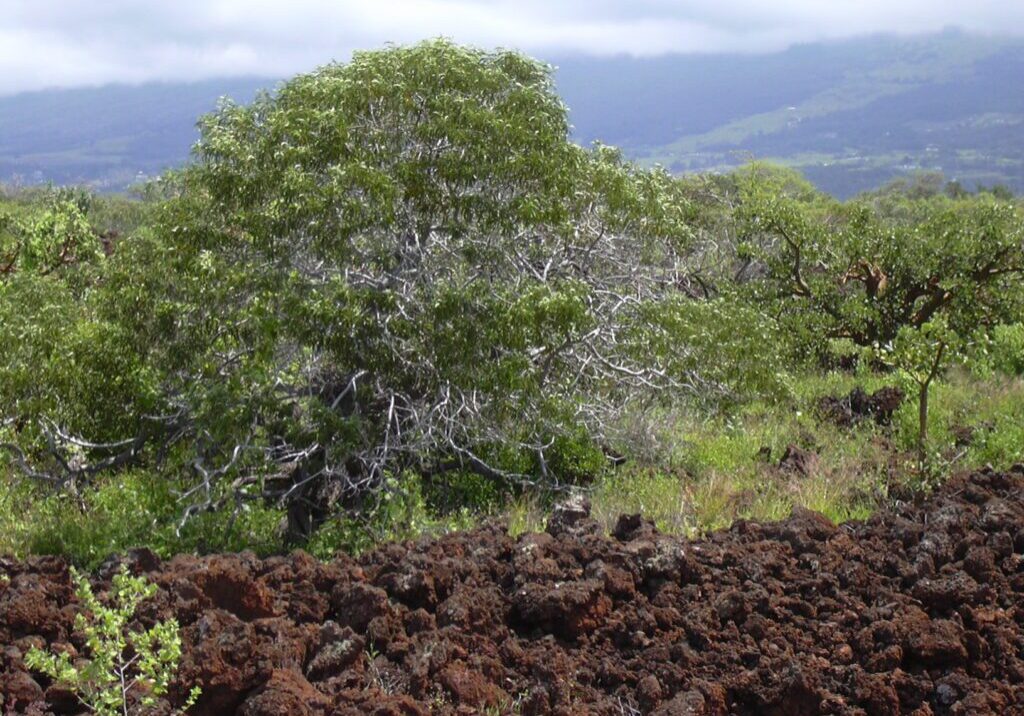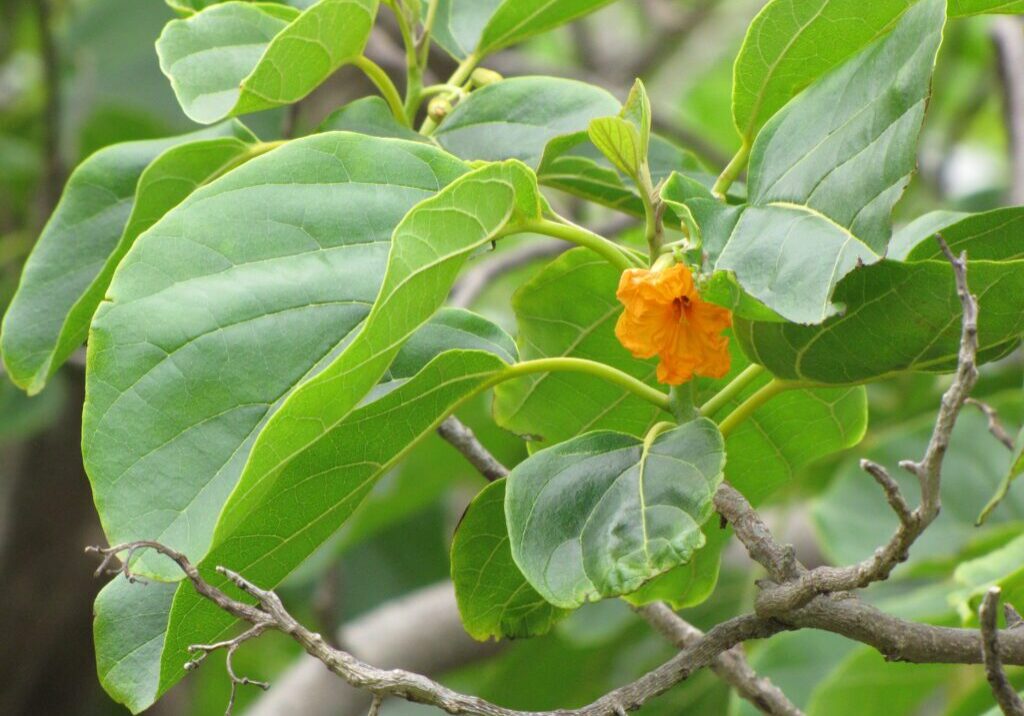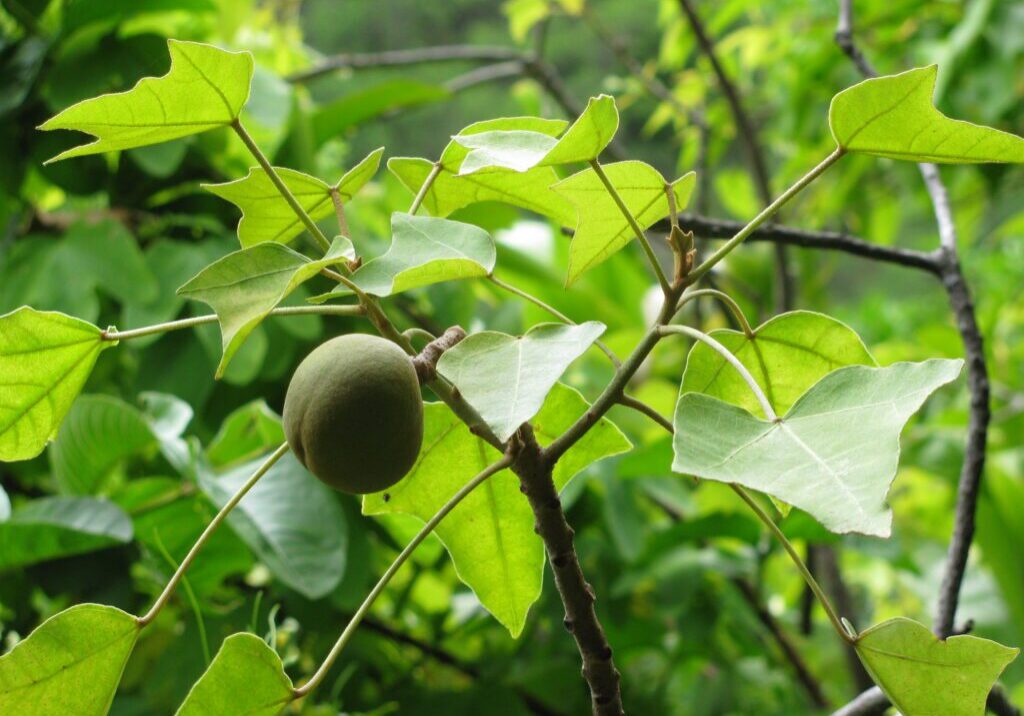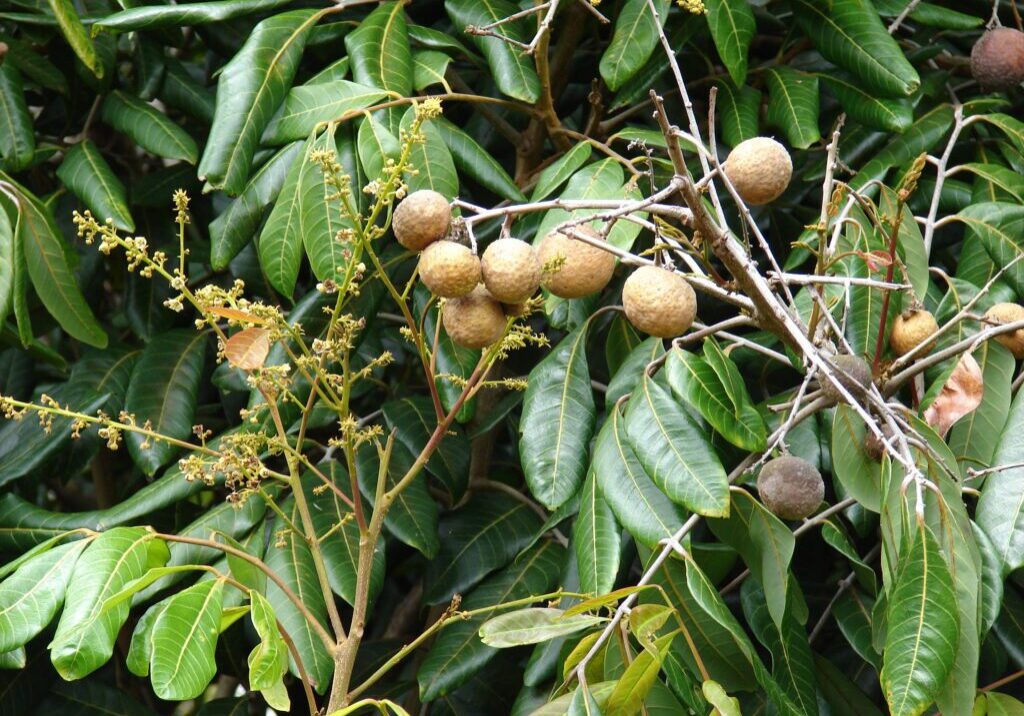Survey Results: Species List of 30 Coastal Plants for Creating Green Breaks
Best practices for survivability and field observations
Many respondents said that the species is long lived and an overall hardy plant while slow growing. A couple noted that it “can handle pruning very well” and “can even be shaped into a hedge under the right circumstances.” One mentioned that once established, it appears to significantly reduce weed growth. A couple of respondents said that it grows well in places like South Kona at 2000′ elevation, Pahole and Ka‘ena (O‘ahu). It is used as a dye and its wood is used for cultural purposes.
Stressors and pests
Pests include borer insects like coffee twig borer, wilt disease (at all stages). One noted that if grown where it’s too damp it becomes an “incredible pest magnet.” It is susceptible to goats and deer which will eat seedlings and younger plants. One respondent said that the species “can handle some salt spray.” Another said it “can handle fire” and that “it will come back after being burned.”
Availability and propagation
Many noted that it is readily available from seeds. Although several noted the fruits can be prolific, the timing of retrieving the seeds and the impact by borers can be tricky. One noted that cuttings are possible, but difficult.
Best practices for survivability and field observations
Many noted that this is a long living, coastal, hardy and useful plant which can be pruned, particularly as a succulent green break, hedge barrier (several noted that it doesn’t do well beyond the coastal zone). One mentioned that it grows aggressively, while another noted its ease in removal if needed. A couple respondents cautioned that “it shouldn’t be overwatered as it grows exuberantly and then needs to be trimmed frequently, etc.” and that “if overwatered can develop fungus/root rot problems.”
Stressors and pests
Overall, an extremely drought tolerant species. A couple of respondents mentioned that it is wind tolerant. However, water stress can be a factor particularly if planting small plants and if planted in really dry areas. Several noted that deer and goats will eat them, especially seedlings and younger plants (during bad droughts). However, another noted that the species can handle major damage from ungulates, erosion and human trampling with vehicles.
Availability and propagation
Many said that it is easy to grow from seeds or from cuttings. Several preferred growing from seeds saying that it was better in dry areas (“cuttings often don’t have as much supporting roots”) and faster than cuttings. One recommended a salt water soak, while another mentioned that the new variegated variety is slower growing.
Best practices for survivability and field observations
Many respondents said that it is an aggressive, sprawling species (especially in streams and gulches), possibly requiring continual maintenance (for example on O‘ahu beach parks, public lands). A couple respondents said it is successful on shorelines, and one noted it can be planted to protect homes from high waves and winds. A couple of respondents said that branches spread and re-root, and that the growth pattern excludes other plants (and may become a problem for nearby irrigation systems). There were mixed reports about how much water is needed to establish and maintain the species. A couple people noted that there is quite a bit of leaf litter associated with this species. Cultural uses include medicine, kaula, tools, kapa dyes.
Stressors and pests
One person noted that whitefly can have a negative impact and that it is palatable to goats.
Availability and propagation
Many noted that it is readily available (for example, on Hawai‘i Island) and easy to grow from cuttings and/or seeds. One said it produces abundant seeds and that seedlings can be translocated. It is “easy to root by cutting if moist soil.”
Best practices for survivability and field observations
One respondent observes that “its thick leaves should do well in dry/mesic environments, although hōʻawa is not considered coastal (except for P. halophilum from Moloka‘i which can handle salt exposure).” Another agrees, saying that although “there are many species and it is hard to generalize, most species will handle most low elevation settings (P. hosmeri, P. glabrum, and P. halophilum, a shrub, endangered coastal form).” The same person observes that P. flocculosum is found only on O‘ahu and P. confertiflorum grows in drier forest types. Another notes that it can create a “good shape for visual barrier or hedge” even if it is “moderately slow growing.” One notes that hō‘awa do well in South Kona (2000′ elevation), while another noted 0% survival rate at Kealia Pond (species of hōʻawa is not known). Cultural uses are for medicine and dyes.
Stressors and pests
All species seem susceptible to drought, yet P. argentifolium, P. confertiflorum, and P. terminalioides, P. halophilum (extremely rare plant from Moloka‘i only) appear more drought tolerant while P. hawaiiense appears less so. One respondent notes that P. hosmeri, P. glabrum, and P. halophilum (shrub, endangered coastal form) are relatively “trouble free.” Although endangered, several recommend P. halophilum for lowland coastal plantings. P. glabrum and P. argentifolium are susceptible to scales and require more moisture. Goats and/or deer will eat seedlings and younger plants (P. glabrum in particular)
Availability and propagation
Limited availability. For example: P. cauliflorum is drought tolerant but limited in availability. Propagation is mostly by seed. For P. confertiflorum and P. glabrum obtaining the fruits and seeds at the right time is crucial. P. hosmeri is easy to grow from seed.
Best practices for survivability and field observations
Several noted that it does well on the wetter sides of islands, preferring shaded and cooler areas (and therefore not requiring irrigation). Another said it is “ very competitive and shady, very durable and hardy, and a good all around fire safe choice.” Another noted that there are large ones growing further back in the wetter/cooler parts of O‘ahu (Wai‘anae Valley, Helemano and back of Palolo).
Stressors and pests
One person said that the fruit may attract pigs.
Availability and propagation
Commercially available and at farmer’s markets. Preferred method is grafting to produce quality fruit, although several note that it is easy to grow from seed. Propagation from cuttings are possible but not as easy or beneficial for long term health due to the absence of defined taproot.
Best practices for survivability and field observations
Many noted that as a coastal shade tree, it is a favorite for restoration since it is robust and can proliferate, becoming aggressive once it produces seeds. It yields prolific fruit while its round nuts can be messy and hazardous to walk on in urban settings (sidewalks). Reviews were mixed about its ability to tolerate hot, dry conditions. One respondent said that at their Moanalua, O‘ahu restoration site, there are seedlings coming up. Another respondent noted that there are also varieties that work in higher elevations (such as on Pohnpei). Cultural uses are for kapa scenting, medicinal, and use of the wood.
Stressors and pests
One noted that goats and/or deer will eat it or rub it, although another mentioned that it has thick, irritating sap (possibly as a deterrent).
Availability and propagation
Several said that it is readily available, fast growing from seed (which can be abundant and are found on each island), and easy to propagate. One noted that a better root system by germinating from seeds. Seedlings can be found under mature trees.
Best practices for survivability and field observations
Mixed reviews on survivability, especially in the coastal, sandy soil zone, with some recommendations for planting above 2,000 ft. While it is fast growing, it is at the same time combustible and flammable. Another mentions that it is best away from direct salt spray. Some level of care is required in the first five years for the tree to become established and drought resistant. Several say it handles in the Koa’ia sanctuary on Kohala Mountain Road (in the wind) and does not need water once established. Cultural uses include the wood, dyes, and for ceremonial purposes.
Stressors and pests
Pests include fusarium wilt, scales (for example at Kealia Pond), black twig borer. Goats and deer will eat seedlings and younger plants.
Availability and propagation
Easy to grow from seed (although mixed reviews on availability) with an emphasis to source the seeds from respective locations. One respondent says that there are only two known populations on Oʻahu (no wild populations in the Wai‘anae range). Several mention that it can be grown from cuttings (although not easily).
Best practices for survivability and field observations
Respondents noted that it is an overall hardy plant known from specific coastal areas on Oahu (Pia Valley, Pearl Harbor, Keawa’ula, various beach parks, public lands) and shorelines specifically. Several said it is a fast grower. Another noted that the species will get low and bushy in higher wind environments. It does really well as an ornamental landscape tree in the urban environment. Another noted that mo‘olelo (stories) tell of the ‘Ewa moku on O‘ahu covered with kou. In modern, urban landscapes some may find that the plentiful large, hard, round fruit are a hazard in walkways needing frequent maintenance. The seed is used in cultural practices of lei making, wood, and kapa cloth dyes.
Stressors and pests
One respondent noted that larger trees (probably 20-25 gallon pots) became really well established in their particular outplanting site. A couple of respondents said that water is required in the beginning for the tree to become adequately established, one saying especially during the first 3 years. Young trees may become partially defoliated and weak, and older trees die from Kou Leafworm Caterpillar (Ethmia nigroapicella) in some areas (for example, Kahului, Wailuku). Noted pests include rose beetles, black twig borer, caterpillar damage, and predation of seeds by rats. One said that roots can rot in wetter areas.
Availability and propagation
Mixed reviews on its availability (DLNR-DOFAW is noted as wanting to plant it). Many note that it is easy to propagate from abundant seeds. One recommends collecting when the fruit is still white (not brown) and planting immediately for good germination. The same respondent notes that “brown fruits have seeds that have entered dormancy and can germinate sporadically for years and years.” A couple of respondents note that some varieties grow easily from cuttings, like the low growing “naio papa type” (from Hawai‘i Island) which is said to be hardier.
Best practices for survivability and field observations
Noted by several respondents that it is a long-living, large, aggressive species, particularly in windward areas, gulches, etc. and that it provides good shade and a moist understory. Another cautioned that its round nuts are hazardous to walk on in urban settings (hard surfaces like sidewalks). A couple of respondents noted that it does produce a lot of nuts which presumably are flammable. Cultural practices include burning for light, medicine, kinolau Kamapuaʻa, kapa dyes, ink, tatoo, lei, kaona enlightenment, food, for use in ceremonies.
Stressors and pests
Pests include Queensland long-horn beetles (attacks mature trees). A couple respondents noted that it is susceptible to rotting, with one noting that this is due to “poor compartmentalization (meaning it doesn’t close its wounds well).” It can attract rats, especially if nuts are not regularly harvested and accumulate on the ground. Several questioned its susceptibility to wind damage. Once moderately established (> 2 feet tall), it appears to be unaffected by weed competition, noting that it can be covered by vines (e.g., Desmodium spp).
Availability and propagation
Many respondents noted that it is readily available, producing lots of seeds, and keiki under mature trees which can be translocated. Some noted that it is fast growing from seeds and is easy to propagate.
Best practices for survivability and field observations
Like lychee, it does best at cooler, upland areas (otherwise prone to irregular flowering and fruiting). One has observed it in yards and private properties. Another mentioned that it really only does well on the wet sides of islands.
Stressors and pests
One noted that water is important for establishment and producing fruit.
Availability and propagation
Not abundantly available. One respondent noted that it is slow growing from propagation (even from grafting). Although it will grow from seed, air layers are best.

